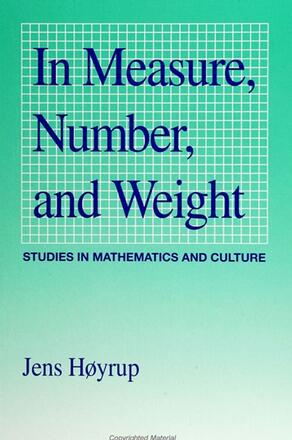1. Varieties of Mathematical Discourse in Pre-Modern Sociocultural Contexts: Mesopotamia, Greece, and the Latin Middle Ages
Introduction
1. Mesopotamia: Scribal Computation and Scribal School Mathematics
2. Greek Mathematics: From Open, Reasoned Discourse to Closed Axiomatics
3. The Latin Middle Ages: A Discourse of Relics
4. Perspectives
2. Subscientific Mathematics: Observations on a Pre-Modern Phenomenon
Introduction
1. The Concepts
2. The Character and Structure of Subscientific Mathematics
3. Traditions and Index Fossils
4. Practical Geometry
5. Algebra
6. The End of Subscientific Mathematics
3. Mathematics and Early State Formation, or The Janus Face of Early Mesopotamian Mathematics: Bureaucratic Tool and Expression of Scribal Professional Autonomy
Introduction
1. Mathematics and the Early State
2. The Early State and Its Origin
3. The Rise of States in Southern Mesopotamia
4. City-States and Centralization
5. Breakdown and Apogee
6. Mathematics
7. From Tokens to Mathematics
8. Trends in Third-Millenniium Mathematics
9. The Paramount Accomplishment of Bureaucracy
10. The Culmination of Babylonian Mathematics
11. Devolution
12. Supplementary Comparative Observations
4. The Formation of "Islamic Mathematics": Sources and Conditions
Introduction
Biographical Cues
1. Introducing the Problem
2. Scientific Source Traditions: The Greeks
3. Scientific Source Traditions: India
4. Subscientific Source Traditions: Commercial Calculation
5. Subscientific Source Traditions: Practical Geometry
6. Algebra and Its Alternative
7. Reception and Synthesis
8. "Melting Pot" and Tolerance
9. Competition?
10. Institutions or Sociocultural Conditions?
11. Practical Fundamentalism
12. Variations of the Islamic Pattern
13. The Importance of General Attitudes: The Mutual Relevance of Theory and Practice
14. The Institutionalized Cases: (1) Madrasah and Arithmetical Textbook
15. The Institutionalized Cases: (2) Astronomy and Pure Geometry
16. A Warning
17. The Moral of the Story
5. Philosophy: Accident, Epiphenomenon, or Contributory Cause of the Changing Trends of Mathematics - A Sketch of the Development from the Twelfth Through Sixteenth Century
Introduction
1. The Twelfth Century
2. The Thirteenth Century
3. The Fourteenth Century
4. The Early Renaissance
5. Epilogue: Mathematics as Part of the Foundation of New Philosophies
6. Jordanus de Nemore: A Case Study on Thirteenth-Century Mathematical Innovation and Failure in Cultural Context
Introduction
1. Preliminary Reflections on Principles
2. Jordanus de Nemore: Who, When, What?
3. The "Latin Quadrivium"
4. "Christian " Quadrivium and "Christian" Learning
5. The Wider Context of Mathematics
6. Jordanus and Illegitimacy. The Jordanian Corpus
7. Arithmetic
8. Geometry
9. Perspective
10. Science of Stars
11. Science of Weights
12. Science of Ingenuities
13. Algorism Revisited
14. Jordanus's Achievement
15. Failure and Its Reasons
16. Epilogue: Epistemology
7. Platonism or Archimedism: On the Ideology and Self-Imposed Model of Renaissance Mathematicians (1400 to 1600)
Introduction
1. The Question of Platonism
2. Renascent Mathematics
3. The Mature Italian Renaissance
4. Northern Humanism
5. The New Philosophies
6. Generalizations
8. On Mathematics and War: An Essay on the Implications, Past and Present, of the Military Involvement of the Mathematical Sciences for Their Development and Potentials
Written in collaboration with Bernhelm Booss-Bavnbek
Introduction
1. The Past
2. The Implications of History
3. Nineteenth-Century Prelude
4. The Era of the World Wars
5. Our Present Situation
6. What Can - and What Should - Be Done?
Notes
Abbreviations and Bibliography
Index
